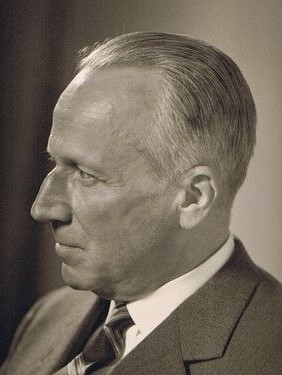
| Born: | 06-14-1893 |
| Faculty: | Medical School | Medical University Vienna |
| Category: | Expelled teacher |
Erich Otto Ludwig ZDANSKY (b. June 14th, 1893 in Vienna, d. November 21th, 1978 Basel/Switzerland) was private lecturer ("Privatdozent") for medical radiology at the Medical School of the University of Vienna in 1938.
He was persecuted in times of Nazism because for so called "political" reasons (he was regarded as "Mischling 2. Grades") lost his position and was forced to leave the university on December 2nd, 1938.
Erich Otto Ludwig Zdansky, son of Karl Zdansky (merchant) and Katharina Ottilie Zdansky, née Wertheim, attended secondary school in Vienna, graduated in 1912 [1] and then studied medicine at the University of Vienna. In 1914 he took part in World War I. He was stationed in Galicia and Russian Poland and fell into Russian war captivity on November 22nd, 1914. He was released on April 3rd, 1918. [2] After the end of the war he continued his studies and obtained his medical doctorate at the University of Vienna in 1920. Following this, he began working at the institute for experimental pathology under Richard Paltauf, and then, in 1922, became an assistant at the University of Basel, where he worked under Paltauf’s student Robert Doerr. Two years later he returned to Vienna and joined the radiology department of the 1st Medical University Clinic at the General Hospital (AKH) under Karel Frederik Wenckebach. Here, Zdansky especially dedicated himself to the dynamic-functional depiction of the heart, the large vessels and the lung on X-ray images. [3] He married Dr. med. Rosalia Kalowa on July 30th, 1927 in Vienna-Alservorstadt. After his habilitation at the University of Vienna in 1933, [4] he became head of the radiology institute of the Wieden hospital in 1937. [5]
At first, Austria’s "Anschluss" to the German Reich did not have any consequences for Zdansky. By a decree dated to December 2nd, 1938, however, the ministry for internal and cultural affairs revoked his venia legendi at the University of Vienna. [6] because he was not considered "Aryan" according to the "Nuremberg race laws". [7] His grandfather on his mother’s side, Univ.-Prof. Dr. Theodor Wertheim (1820-1864, converted from jewish to rom.-cath. faith in 1854), had been a "half-Jew" and, according to Zdansky, had only gotten "baptized later in life". [8] He was able to remain in his function at the Wiedener Hospital. [9] At the same time, his brother Otto Zdansky (1894-1988) was regarded not only as "Mischling" but as "Jewish", was deprived of his academic degree (gained in 1921) in 1940/41 and was denationalized for racist reasons.[9a]
After the end of the war, Zdansky was rehabilitated and the Staatsamt fuer Volksaufklaerung (government office for public enlightenment) reinstated his venia docendi on September 10th, 1945. [10] In that same year he became head of the radiology department of the hospital Rudolfstiftung and received the title of associate professor. Two years later he advanced to chairman of the Central X-ray Institute in the General Hospital [11] and received a teaching assignment ("Extraordinariat") at the University of Vienna. [12] He gained renown through his work on angiocardiography and established the first radiotherapeutic ward at the General Hospital. When he accepted a call to a full professorship at the University of Basel in 1954, this ward was closed down. Zdansky remained at the University of Basel until he received emeritus status in 1965.
Zdansky’s most important work is considered to be his paper "Roentgendiagnostik des Herzens und der großen Gefaesse", published in 1939. From 1951 until 1953 he was the president of the Austrian X-ray Society. [13]
Prof. Dr. Erich Zdansky died on November 21st, 1978 in Basel (Switzerland).
Lit.: Austrian State Archive (OeStA)/Archive of the Republic (AdR)/personal file Zdansky, OeStA/Allgemeines Verwaltungsarchiv (AVA)/personal file Zdansky; Archive of the University of Vienna (UA), Medical School MED PA 566, MED GZ 1200 ex 1938/39, MED 160 ex 1944/45, Academic Senate S 304.1434; WER 1951; MERINSKY 1980; Michael HUBENSTORF, Medizinische Fakultät 1938–1945, in: Gernot Heiss et al. (eds.), Willfaehrige Wissenschaft. Die Universitaet Wien 1938 bis 1945, Vienna 1989, 233–282; MUEHLBERGER 1993, 36; CZEIKE 1992-1997 [2004], Vol. 5; BLUMESBERGER 2002, 1509; TRAGL 2007; POSCH 2009, 275, 497f.; UB MedUni Wien/van Swieten Blog.
[1] UA, PA, fol. 1, Personalangabe, o. D.
[2] OeStA/AdR, PA, Curriculum vitae, August 1945.
[3] Felix Czeike, Historisches Lexikon Wien. Bd. 5, Wien 1997.
[4] Vgl. UA, PA, fol. 1, Personalangabe, o. D.
[5] Czeike, Lexikon.
[6] OeStA/AdR, PA, Personenstandesblatt, 6. 8. 1945.
[7] Ebd., BMU GZ 63909/Pr. III-B/47, Vermerk, o. D.
[8] OeStA/AdR, Curriculum vitae, August 1945.
[9] Michael Hubenstorf, Medizinische Fakultät 1938–1945, in: Gernot Heiss et al. (eds.), Willfaehrige Wissenschaft. Die Universitaet Wien 1938 bis 1945, Vienna 1989, 233–282, 257.
[9a] Herbert Posch, Akademische "Würde". Aberkennungen und Wiederverleihungen akademischer Grade an der Universität Wien im 19. und 20. Jahrhundert, ungedr. phil. Diss. Univ. Wien, Vienna 2009, 275, 497f.
[10] UA, PA, fol. 6, Staatsamt f. VA an MED Dekanat, 10. 9. 1945.
[11] Czeike, Lexikon.
[12] Wer ist wer in Oesterreich, Vienna 1951.
[13] Czeike, Lexikon.
Andreas Huber (translated by Thomas Rennert)